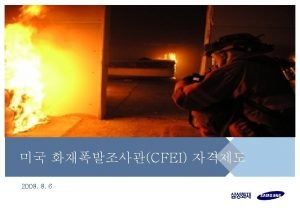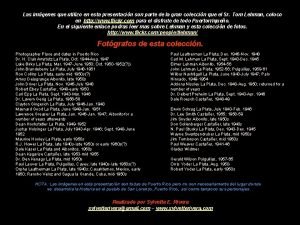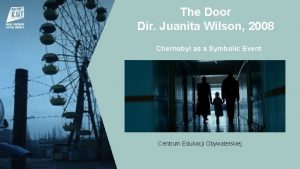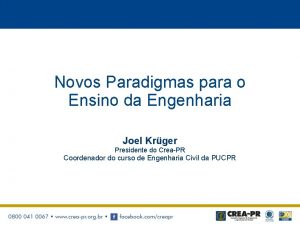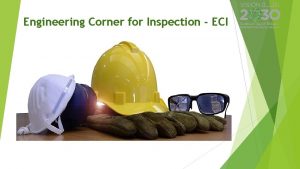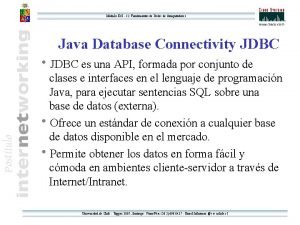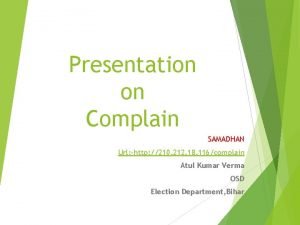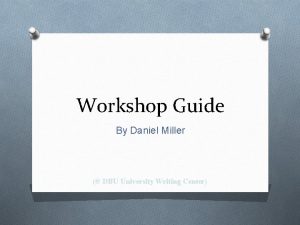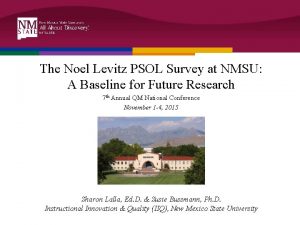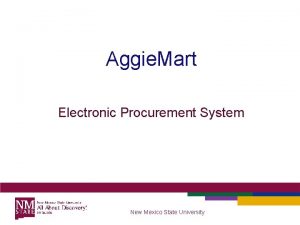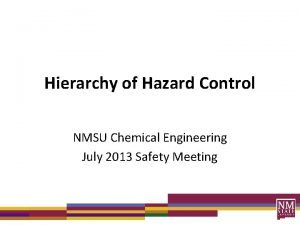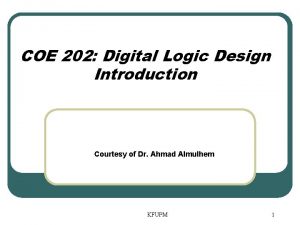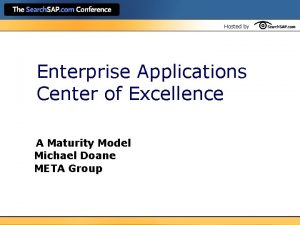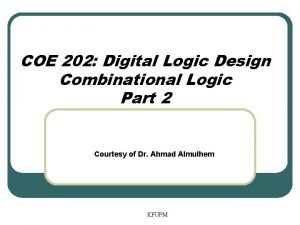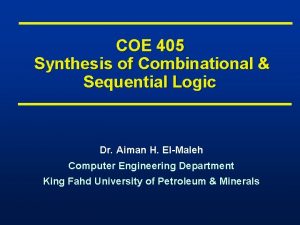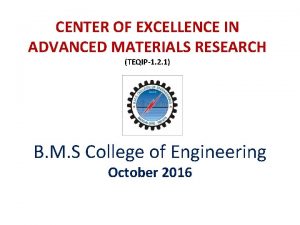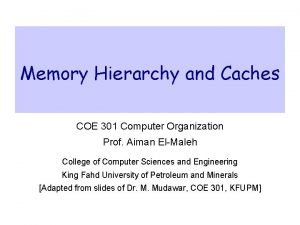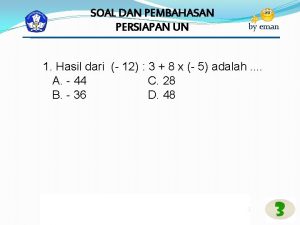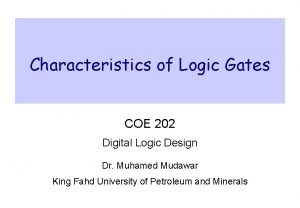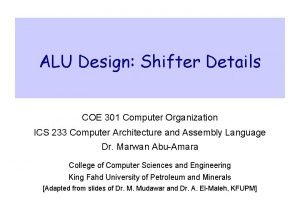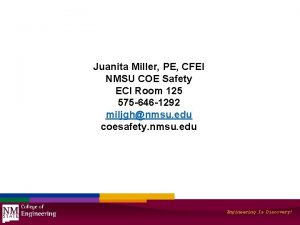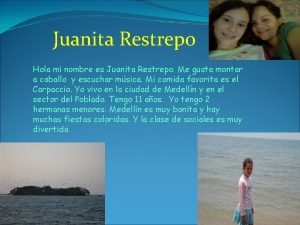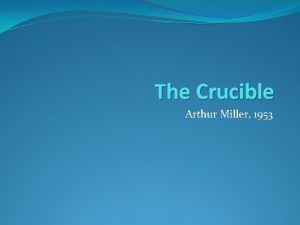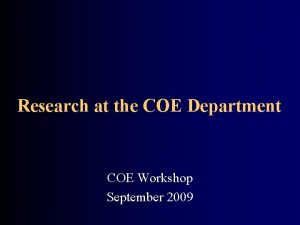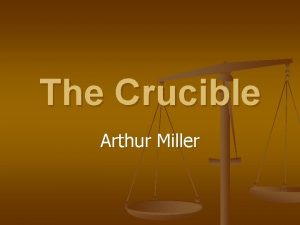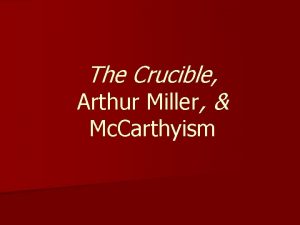Juanita Miller PE CFEI NMSU COE Safety ECI








































- Slides: 40

Juanita Miller, PE, CFEI NMSU COE Safety ECI Room 125 575 -646 -1292 miljgh@nmsu. edu coesafety. nmsu. edu Engineering Is Discovery!

Management of Change

Risk and Change Management • Review risk management concepts – What can go wrong? – How likely is it? – What are the consequences? • Methods of Risk Analysis – Checklist – “What If” – FMEA - HAZOP - Fault Tree

Risk Analysis • Risk Analysis: The identification and evaluation of hazards to individuals, property and the environment posed by natural and human-caused events • Risk Analysis: – Qualitative or Quantitative

Risk Defined A very common definition of risk represents it as a set of triplets [2 -1]: scenarios, likelihoods, and consequences. Determining risk generally amounts to answering the following questions: 1. What can go wrong? 2. How likely is it? 3. What are the consequences? Source: Probabilistic Risk Assessment Procedures Guide for NASA Managers and Practitioners 2 nd ed 12/2011; http: //www. hq. nasa. gov/office/codeq/doctree/SP 20113421. pdf

Management of Change • All changes carry risk – Safety – Functionality – Economic • What constitutes a change? – It depends … – But sometimes very small changes can have huge effects 6

Change as defined by PSM 29 CFR 1910. 119 (OSHA) • … change includes all modifications to equipment, procedures, raw materials and processing conditions other than “replacement in kind” 7

Other Definitions of a Change • Anything that is different from the original • Any part of a item that doesn’t meet the specification • A difference – Procedure – Process Conditions – Programming

Change as defined by PSM 29 CFR 1910. 119 (OSHA) • Changes to process technology – – – production rates raw materials new equipment procedures programming • Temporary changes – Piping – Instruments – Experimental Equipment

Change as defined by PSM 29 CFR 1910. 119 (OSHA) • Changes to equipment – materials of construction – equipment specs – piping • Changes to instrumentation – feedback and feedforward control – alarms – interlocks



Small Change with Big Impact Does this look like a change?

Cat Litter Comparison Tidy Cat - SDS Swheat Scoop - Ingredients

WIPP Site Fire/Explosion Feb 2014 • Drum 68660, from the Los Alamos National Laboratory (LANL), ruptured while housed underground • The report deemed that the Swheat Scoop brand litter used by LANL was chemically incompatible with the contents of the drum. • The organic ingredients reacted with the waste and created gases that increased the pressure of the drum. The materials self-heated and combusted. • The breach contaminated 21 workers with low-level doses of radiation and caused … shutdown of WIPP.

WIPP Site Fire/Explosion Feb 2014 • Unfortunately, workers at Los Alamos National Laboratory, also in New Mexico, apparently switched from inorganic clay litter to organic litter. According to the report, workers put the brand "Swheat Scoop" inside drum 68660. • "Experiments showed that various combinations of nitrate salt, Swheat Scoop®, nitric acid, and oxalate selfheat at temperatures below 100°C. Computer modeling of thermal runaway was consistent with the observed 70 -day birth-to-breach of Drum 68660, " http: //www. npr. org/sections/thetwo-way/2015/03/26/395615637/officialreport-nuclear-waste-accident-caused-by-wrong-kitty-litter Source: http: //www. cnbc. com/2015/03/27/kitty-littermix-up-caused-nuclear-waste-explosion. html

Hyatt Hotel Walkway Collapse

Kansas City, MO July 17, 1981

HYATT REGENCY HOTEL WALKWAYS COLLAPSE ENGINEERING FAILURE By: Julee Christianson, Mike Cruz, and Katie Nolan

Original Design The 2 nd and 4 th floor walkways were originally supposed to be suspended from the same rod and held in place by nuts Modified Design (was used) The fabricator had modified the design to use two hanging rods and the engineers approved the change without checking it On a preliminary design a note was made that the hanging rods needed to have strength of 413 MPa, but that note was left out on the final design and so the fabricator used hanger rods with only 248 MPa of strength

THE HANGER ROD THREADS, WASHER AND SUPPORTING NUT NOTE: THE DEFORMATION IN THE WASHER CAUSED THE BEAM TO SLIP

CLOSE-UPS OF SOME OF THE 4 TH FLOOR BEAMS

Hyatt Hotel Walkway Collapse • What change was made? – Design: Single rod long rod from roof to 2 nd floor walkway – As Constructed: Two rods connected in a box beam below the 4 th floor walkway • Contributing factors? – Nut size – Stress at interface with nut in box beam – People dancing on the walkways?

Animal Feed Manufacturer • Purchased “starch” additive from a Dutch company to incorporate into milk substitute • Dutch company ran out of stock of this starch • Purchasing bought “starch” from a UK firm – Assumed to be the same material composition – Turned out to be highly toxic • Poisoned 68, 000 calves, Killed 4, 600

Management of Change at BP • Video https: //www. youtube. com/watch? v=u. Cy. Xt. Jbu. IZw

Instructions and Shortcuts • Instructions don’t always tell you why • You should never take shortcuts or make modifications – Evalute the impact of the change – Receive authorization for the change

Example of Instruction Modification An operator had to empty some tank trucks by gravity. He hand been instructed to do the following: 1. Open the valve on top of the tank 2. Open the drain valve 3. When the tank was empty, close the valve on the top of the tank. He had to climb onto the top of the tank twice. He therefore decided to close the vent before emptying the tank. To his surprise, the tank was sucked in. Case story from: “What Went Wrong” by Trevor Kletz

FMEA EXAMPLE

FMEA Example Bomb Calorimeter – Background • Instrument housed in a Chemistry Lab • Multiple researchers working in that area most from Chemistry Department • Chemistry students don’t follow ESP process • No way to isolate the instrument when its running • Instrument has potential for explosion outside housing confines

Example – Analytical Instrument Bomb Calorimeter

Photos of Bomb Calorimeter

FMEA Continued • Develop scenarios (What can happen? ) – Add as many as serve the purpose – Always better to have too many than too few • Describe the failure: – Frequency (How Often? ) – Consequences (How bad is it? ) – Detectability (Did you have any warning? ) – Recommendations (How might you prevent this? )


FMEA Continued •


Summary of Change Types • • • Equipment Materials of construction Raw materials Procedures Processing Conditions Instrumentation

Change Control Process • You will have to deal with changes – Suppliers go out of business – Equipment becomes outdated – Engineers find better ways to do things – Industry finds cheaper materials – Contractors requests – Government mandates greener methods

Change Control Process • Same methodology as evaluating any risk – Gather information – Analyze the change using the “triplet” questions • What can go wrong? • How likely is it? • What are the consequences? – Consider how a change effects the original system – Be wary of any new factors resulting from the change

Replacement in Kind • What is Replacement in Kind? – A replacement that satisfies the design specification (OSHA 19 CFR 1910. 119 (b)) – You (or your company) establishes the specs • • Specs don’t always cover all eventualities Specs don’t explain why things were chosen Specs can be open to interpretation Process/Machine/System Documentation is critical

Summary • Changes inevitable – Coordinate and approve changes – Review changes – Ensure work is completed properly
 Cfei practice exam
Cfei practice exam Mama juanita
Mama juanita Class of
Class of The door juanita wilson
The door juanita wilson Election monitoring dashboard
Election monitoring dashboard Eci mac
Eci mac Eci ecef
Eci ecef Engineering corner for inspection
Engineering corner for inspection Eci principles
Eci principles Eci 11
Eci 11 Samadhan eci
Samadhan eci What is p e c s
What is p e c s Medical plaza miller 131 miller street
Medical plaza miller 131 miller street Write the procedure to find miller indices of a given plane
Write the procedure to find miller indices of a given plane Dbu writing center
Dbu writing center Digital measures nmsu
Digital measures nmsu Nmsu irb
Nmsu irb Aggie mart
Aggie mart Nmsu scholar dollar
Nmsu scholar dollar Nmsu blackboard
Nmsu blackboard Chemical engineering nmsu
Chemical engineering nmsu Study abroad nmsu
Study abroad nmsu Ict nmsu
Ict nmsu Nmsu south campus housing
Nmsu south campus housing 202
202 Coe 202 kfupm
Coe 202 kfupm Center of excellence framework
Center of excellence framework Pos expression can be implemented using
Pos expression can be implemented using Coe logic
Coe logic Nato ensec coe
Nato ensec coe Coe 301
Coe 301 Bmsce coe
Bmsce coe Coe 301 kfupm
Coe 301 kfupm Coe department kfupm
Coe department kfupm Oogoogle classroom
Oogoogle classroom Besar coe pada gambar diatas adalah
Besar coe pada gambar diatas adalah Coe 202
Coe 202 Coe 233 kfupm
Coe 233 kfupm Coe 202
Coe 202 Coe 202
Coe 202 Richard murray coe
Richard murray coe
